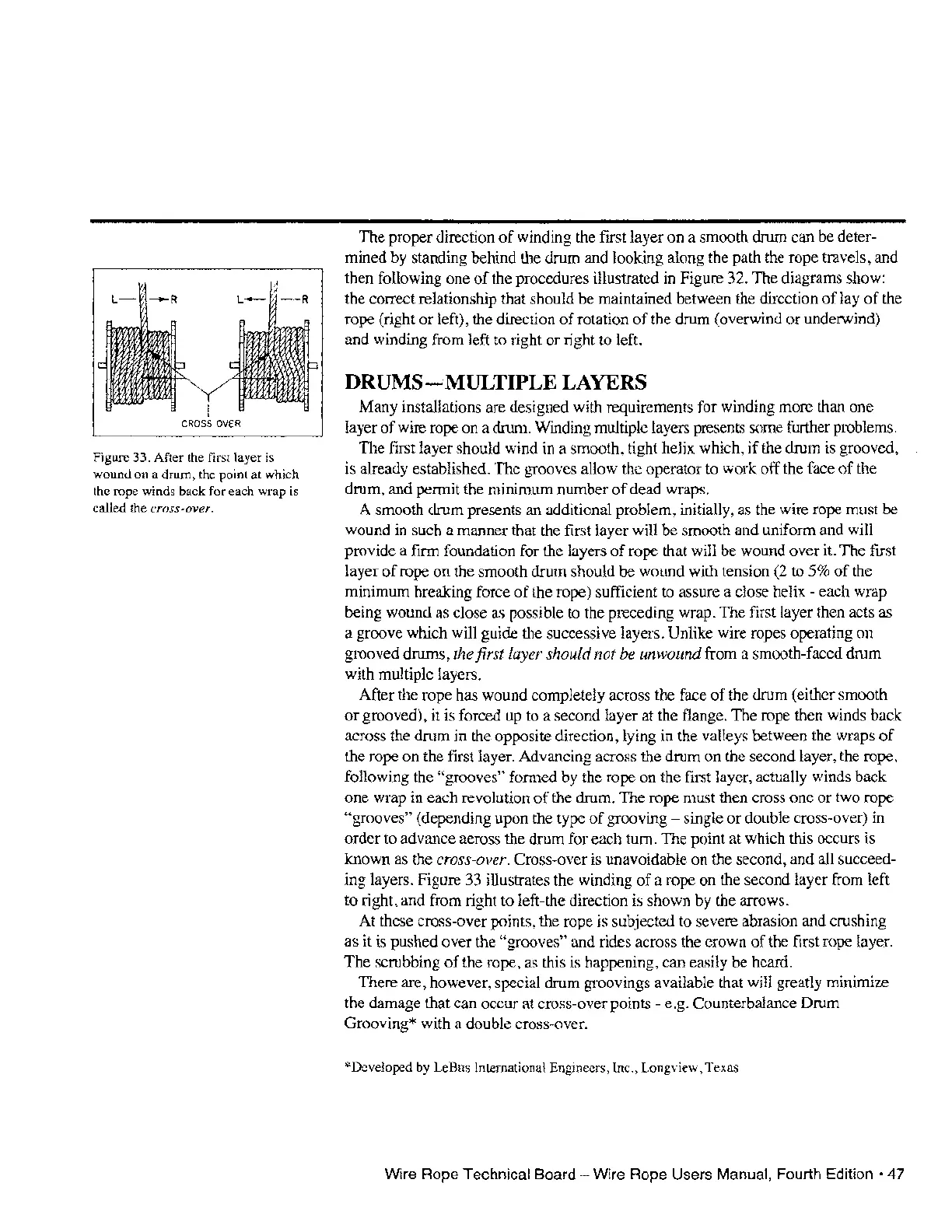CROSS
OVER
Figure 33. After the first layer is
wound on a drum, the point at which
the rope winds back for each wrap is
called the
cross-over.
The proper direction
of
winding the first layer
on
a smooth drum can be deter-
mined by standing behind the drum and looking along the path the rope travels, and
then following one
of
the procedures illustrated in Figure 32. The diagrams show:
the correct relationship that should
be
maintained between the direction
of
lay
of
the
rope (right
or
left), the direction
of
rotation
of
the drum (overwind
or
underwind)
and winding from left to right
or
right to left.
DRUMS.....;MULTIPLE
LAYERS
Many installations are designed with requirements for winding more than one
layer
of
wire rope on a drum. Winding multiple layers presents some further problems.
The first layer should wind
in
a smooth, tight helix which,
if
the drum
is
grooved,
is already established.
The
grooves allow the operator to work
off
the face
of
the
drum, and permit the minimum number
of
dead wraps.
A smooth drum presents an additional problem, initially, as the wire rope must be
wound in such a manner that the first layer will
be
smooth and uniform and will
provide a firm foundation for the layers
of
rope that will be wound over it. The first
layer
of
rope
on
the smooth
drum
should
be
wound with tension (2 to 5%
of
the
minimum breaking force
of
the rope) sufficient to assure a close helix - each wrap
being wound as close as possible to the preceding wrap. The first layer then acts as
a groove which will guide the successive layers.
Unlike wire ropes operating on
grooved drums,
the first layer should not be unwound from a smooth-faced drum
with multiple layers.
After the rope has wound completely across the face
of
the drum (either smooth
or
grooved),
it
is forced up to a second layer at the flange. The rope then winds back
across the drum in the opposite direction, lying in the valleys between the wraps
of
the rope
on
the first layer. Advancing across the drum on the second layer, the rope,
following the
"grooves" formed by the rope on the first layer, actually winds back
one wrap in each revolution
of
the drum. The rope must then cross one
or
two rope
"grooves" (depending upon the type
of
grooving - single
or
double cross-over) in
order to advance across the drum for each turn.
The
point at which this occurs is
known as the
cross-over. Cross-over is unavoidable on the second, and all succeed-
ing layers. Figure 33 illustrates the winding
of
a rope
on
the second layer from left
to right, and from right to left-the direction is shown by the arrows.
At these cross-over points, the rope is subjected to severe abrasion and crushing
as
it
is pushed over the "grooves" and rides across the crown
of
the first rope layer.
The scrubbing
of
the rope, as this is happening, can easily
be
heard.
There are, however, special drum groovings available that will greatly minimize
the damage that can occur at cross-over points
- e.g. Counterbalance Drum
Grooving* with a double cross-over.
"Developed by LeBus International Engineers, Inc., Longview, Texas
Wire Rope Technical Board - Wire Rope Users Manual, Fourth
Edition'
47
